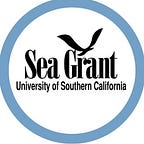Oil and water
The unexpected mixture that paved the way for University of Southern California Sea Grant
By Charlotte Stevenson, Science Writer, USC Sea Grant
On January 28, 1969, Union Oil Well Platform A, six miles southeast of Santa Barbara, began to leak oil into the Santa Barbara Channel. The company struggled to control the spill for weeks, and local waters, beaches, and wildlife were severely affected. There was great confusion as to why the spill had occurred, what the immediate biological and ecological effects were, and what long-term effects should be expected.
What resulted was something that we might call a “well-intentioned cluster.” Many private, government, and university agencies were all simultaneously trying to answer these pressing questions. Entities involved included the State Water Quality Control Board, the Federal Water Pollution Control Administration, State Fish, and Game, the U.S. Bureau of Commercial Fisheries, the United States Geological Survey, the Coast Guard, the Corps of Engineers, the University of California at Santa Barbara, the California Institute of Technology, the University of Southern California (USC), the Southern California Academy of Sciences, and the American Petroleum Institute, along with many others not listed here.
A coordinated effort was imperative, so the Western Oil and Gas Association looked for an entity that could coordinate the evaluation effort, had superior organizational skills, was well respected among all parties, and would uphold the best available science. The Allan Hancock Foundation at USC was chosen and awarded funding. The Foundation also received supplemental funding from the relatively new National Sea Grant Program, which had just been moved in 1970 from the National Science Foundation to the newly created National Oceanic and Atmospheric Administration (NOAA) in the U.S. Department of Commerce.
USC wasn’t named an official Sea Grant Program until two years later in 1972, but the work done in 1970 and 1971 by USC’s Allan Hancock Foundation, with the University’s first National Sea Grant funding, was quintessential “Sea Grant” work. In fact, the earliest known document associated with the USC Sea Grant Program is a 436-page report called Biological and Oceanographic Survey of the Santa Barbara Oil Spill, 1969–1970, which was published in 1971. This beast of a report has 18 chapters, covering topics from historical oils seeps to whale health to sediment bacteria and everything in between. Each focused chapter is written by a different expert and incorporates the research and findings of all agencies working at that time.
This report reveals the Program’s extensive work in coordinating a vast range of scientific expertise, managing stakeholders from diverse backgrounds, and compiling information into a reference document accessible to everyone, all of which sounds like projects USC Sea Grant is doing right now in 2020, 50 years later!
Further, in the realm of oil spill preparedness, response, and coordination, USC Sea Grant is still considered a national leader. In 2017, the National Academies of Science, Engineering, and Medicine’s Gulf Research Program (GRP) revealed that almost ten years after the Deepwater Horizon oil spill, many questions remain about how to address the human health and socioeconomic impacts during oil spills. The GRP wanted regional level input to identify common and region-specific needs to inform the human dimensions of oil spill preparedness.
Of the 34 Sea Grant programs in the country, six, including USC Sea Grant, received national support to coordinate a series of workshops to identify common and region-specific needs to inform analyses of human dimensions of oil spill preparedness. USC Sea Grant’s workshop focused on a 2019 pipeline spill that occurred in Santa Barbara County. The report that resulted from the workshop was recognized by the National Institutes of Health and publicly recommended them as significant oil spill preparedness reading material, adding to the U.S. National Library of Medicine.
and Response in Santa Barbara Oil Spill” in Santa Barbara, CA.
In a way, USC Sea Grant was born at a time of need in Southern California. But that need has never gone away. Instead, USC Sea Grant has grown from a small group of people working on the 1969 Santa Barbara Oil Spill to a program with a 50-year history working on a vast array of Southern California’s coastal issues, including harmful algal blooms, water quality, toxicology, recreational and commercial fisheries, aquaculture, invasive species, shipping, port environmental initiatives, climate change adaptation, beach ecology, wetland restoration, seafood safety, and environmental education. As Southern California continues to be impacted by coastal issues and environmental factors, such as oil spills, USC Sea Grant’s rich history in working, leading, and coordinating efforts on these issues further reveals the program’s strong dedication and long-term commitment to solving the region’s most pressing problems of the past, present, and future.
Media Contact: Leah Shore / lshore@usc.edu / (213)-740–1960
Originally published at https://dornsife.usc.edu on October 30, 2020
